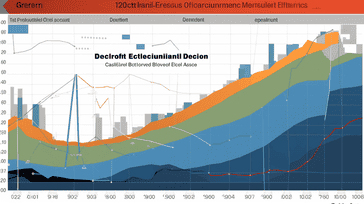
Retirement planning is an often-overlooked aspect of financial planning but is crucial in ensuring a comfortable and stress-free retirement. In this article, we will explore the steps involved in creating a solid retirement roadmap, including saving for retirement and planning your retirement income. We will also discuss the benefits of starting early and setting realistic retirement goals. By the end of this article, you will have a clear understanding of how to plan for your retirement and achieve financial freedom.
Key Takeaways
- Retirement planning is essential for a secure future.
- Assess your retirement needs and use retirement plan calculators to determine how much you need to save for a comfortable retirement.
- Design a retirement budget that ensures a sustainable income throughout your retirement years.
- Investing in a diversified portfolio can help you build a strong financial foundation for your retirement.
- Long-term care planning and estate planning are crucial components of retirement planning.
Why Retirement Planning is Essential for a Secure Future
Retirement may seem like a far-off life stage, but it is never too early to start planning for it. In fact, the sooner you start thinking about retirement, the better off you will be in the long run. Retirement planning is essential for a secure future, and here's why.
Starting Early Gives You More Time
One of the most critical aspects of retirement planning is starting early. By starting your retirement savings in your 20s or 30s, you have more time to accumulate wealth, and your investments have more time to grow. Starting early also allows you to take advantage of compounding interest, which can significantly increase your retirement savings over time.
Setting Realistic Retirement Goals
Another important aspect of retirement planning is setting realistic retirement goals. This means taking into account your current income, expected expenses, and lifestyle choices. With realistic goals in mind, you can create a suitable retirement plan and adjust it as necessary to ensure that you achieve your financial objectives.
Saving Diligently
Retirement planning also involves saving diligently. You need to set aside a portion of your income each month to ensure that you have enough savings to cover your expenses during retirement. This requires discipline, but it is essential to ensure that you can enjoy your retirement years without financial stress.
Tips for Effective Retirement Planning
To ensure effective retirement planning, consider the following tips:
- Start by setting a retirement savings goal and create a plan to achieve it.
- Take advantage of retirement savings accounts, such as 401(k)s or IRAs.
- Consider working with a financial advisor to help you create a comprehensive retirement plan.
- Invest your retirement savings in a diverse range of investments to reduce risk and increase returns.
- Regularly review and adjust your retirement plan to ensure that you stay on track towards your financial goals.
Conclusion
Retirement planning is crucial for a secure future. By starting early, setting realistic goals, and saving diligently, you can ensure that you have enough savings to support your desired lifestyle during retirement. Consider working with a financial advisor to ensure that your plan is comprehensive and effective, and regularly review and adjust your plan to reflect changes in your life circumstances.
Assessing Your Retirement Needs: Calculating Retirement Savings

When it comes to retirement planning, one of the most critical steps is assessing your retirement needs. You need to determine how much money you require to lead a comfortable life in your golden years. There are various retirement planning tools that can help with this, such as retirement plan calculators.
Retirement Plan Calculator
A retirement plan calculator is an online tool that enables you to estimate how much retirement savings you'll need based on your current savings and future planned contributions. Most retirement plan calculators require you to input details like your current age, anticipated retirement age, total retirement savings up to date, expected annual retirement income, and life expectancy. After you input all these details, the calculator will generate a projection of how much money you will have in retirement and whether or not it is sufficient.
It's essential to use a reliable retirement plan calculator to make accurate projections. Most retirement plan calculators provide assumptions and disclaimers regarding their calculations, which you should carefully review to determine their accuracy and relevance to your situation.
Retirement Savings
Once you've determined how much retirement savings you need, the next step is to start saving. If you haven't started yet, it's time to begin. The sooner you start saving, the more time your money has to grow, which means more money in your retirement nest egg. Starting with small amounts is okay, but the earlier you start, the less you'll have to save every month to reach your retirement savings goal.
It's also essential to understand the different types of retirement plans available to you, including employer-sponsored plans like 401(k) plans, traditional and Roth IRAs, and self-employed retirement plans. You should take advantage of these plans to maximize your savings potential and reduce your tax bill.
Retirement Planning Tools
Several other retirement planning tools can help you create a retirement roadmap beyond retirement plan calculators. One example is an online retirement planning service that can help you create a customized retirement plan based on your specific needs and goals. These services provide a comprehensive analysis of your financial situation, including retirement income, Social Security benefits, and other sources of income.
Other retirement planning tools include financial planning software, budgeting apps, and investment calculators that can help you track your progress towards your retirement savings goal. These tools can help you stay on track, identify areas where you can save more, and make adjustments to your plan as needed.
In summary, assessing your retirement needs is the critical first step towards achieving financial security in retirement. You can use retirement plan calculators, save diligently, and utilize retirement planning tools to create a retirement roadmap that enables you to live comfortably in your golden years.
Designing Your Retirement Budget: Creating a Sustainable Income
When planning for retirement, designing a budget is a crucial step to ensure a sustainable income throughout your retirement years. Here are some retirement planning tips to help you create a budget that works for you:
Manage Your Expenses
First, it's essential to manage your expenses carefully. Consider your fixed expenses, such as housing, insurance, and healthcare costs, as well as your discretionary spending, such as entertainment and travel. By keeping a close eye on your expenses, you can adjust your budget accordingly to ensure you have enough income to cover your needs.
Maximize Social Security Benefits
Social Security benefits can play a significant role in your retirement income. To maximize your benefits, consider delaying your claim until you reach full retirement age or even later, if possible. This can significantly increase your monthly benefit amount, resulting in more income throughout your retirement years.
Explore Additional Sources of Income
In addition to Social Security, there are several other sources of retirement income you can explore. Consider part-time work, rental income, or even starting your own business to supplement your retirement income. By diversifying your income sources, you can create a more stable and sustainable retirement budget.
In conclusion, designing a retirement budget that creates a sustainable income is essential for a stress-free retirement. By managing your expenses, maximizing Social Security benefits, and exploring additional sources of income, you can create a retirement budget that works for you. Keep these retirement planning tips in mind as you create your retirement roadmap.
Retirement Investment Strategies: Building a Strong Financial Foundation

Retirement investment strategies are essential for building a strong financial foundation that can sustain you throughout your retirement years. However, selecting the right investment options that align with your retirement goals can be overwhelming. In this section, we'll provide insights on how to navigate retirement planning tools and select the right investment strategies for your needs.
Exploring Retirement Investment Options
When it comes to retirement investment strategies, it's crucial to diversify your portfolio to minimize risks. A well-diversified portfolio can include stocks, bonds, mutual funds, real estate, and other investment options. Each investment option has its unique features, risks, and potential returns, making it essential to do your due diligence before investing.
"Diversification is the only free lunch in investing." - Harry Markowitz
The above quote by Harry Markowitz, a Nobel Prize-winning economist, emphasizes the importance of diversification. By investing in different asset classes, you can lower risks and boost returns. Here is a brief overview of some retirement investment options:
| Investment Option | Features | Risks | Returns |
|---|---|---|---|
| Stocks | Ownership in a company | Market volatility | Potentially high returns |
| Bonds | Debt security | Interest rate risk | Lower returns but relatively low risk |
| Mutual Funds | Investment in multiple assets | Management fees | Potentially high returns with diversification benefits |
| Real Estate | Investment in property | Market fluctuations and maintenance costs | Potentially high returns with rental income and capital appreciation |
Retirement Planning Tools
Retirement planning tools can help you select the right investment options and assess your retirement income needs. These tools can include retirement plan calculators, investment analysis tools, and portfolio management software. By leveraging these tools, you can make informed decisions and stay on track towards your retirement goals.
When using retirement planning tools, it's essential to consider factors such as your retirement age, life expectancy, and estimated expenses. By factoring in these variables, you can adjust your retirement investment strategies to ensure you have adequate retirement savings.
Conclusion
Retirement investment strategies are vital for achieving financial security and a stress-free retirement. By diversifying your portfolio and leveraging retirement planning tools, you can make informed investment decisions that align with your retirement goals. Remember to review and adjust your investment strategies regularly to ensure your portfolio stays relevant and effective.
Long-Term Care Planning: Protecting Your Retirement Assets
Long-term care planning is an important aspect of retirement planning, as it helps protect your retirement assets from being depleted by healthcare expenses. According to a 2020 study by the Department of Health and Human Services, about 70% of individuals aged 65 and above will require some form of long-term care in their lifetime.
There are different options available for long-term care planning, including long-term care insurance and Medicaid. Long-term care insurance is a private insurance policy that helps cover the costs of in-home care, assisted living, or nursing home care. Medicaid, on the other hand, is a government-funded program that provides healthcare coverage for individuals with low income and limited resources.
When considering long-term care planning, it's important to assess your needs and research the different options available. Consulting a financial advisor or retirement planning service can also provide valuable insights and guidance in choosing the right approach for your specific situation.
Estate Planning: Leaving a Lasting Legacy

Estate planning is a crucial element of retirement planning as it ensures that your assets are distributed according to your wishes. With a comprehensive estate plan, you can protect your loved ones and leave a lasting legacy.
Wills and Trusts
One of the primary components of estate planning is creating a will. It is a legal document that outlines how you want your assets to be distributed after your death. Without a will, the state will decide how your estate will be divided, which might not align with your wishes.
Another option is to create a trust. It is a legal arrangement in which a trustee manages your assets on behalf of your beneficiaries. Trusts offer more flexibility than wills as they can help you avoid probate, minimize estate taxes, and protect assets from creditors.
Power of Attorney
An essential part of estate planning is assigning someone to manage your finances and make decisions in case you become incapacitated or unable to make your own decisions. This person is called a power of attorney. It can be a family member, a trusted friend, or a professional.
Beneficiary Designations
You should also review your beneficiary designations for your retirement accounts, life insurance policies, and other assets regularly. These designations determine who will receive the proceeds after your death.
Professional Services
While it is possible to create an estate plan on your own, it is highly recommended to seek the help of a professional. They can guide you through the legal complexities and help you create a plan that meets your unique needs and goals.
Overall, estate planning is a crucial component of retirement planning that cannot be overlooked. With a solid estate plan, you can ensure that your assets are distributed as you wish and leave a lasting legacy for your loved ones.
Maximizing Retirement Benefits: Social Security and Pensions
When planning for retirement, it's essential to maximize your retirement benefits, including Social Security and pensions. Here are some retirement planning tips to help you make the most of your retirement income:
Claim Social Security Benefits at the Optimal Time
Deciding when to claim Social Security benefits is a significant retirement income planning decision. Claiming benefits early can reduce your monthly payments, while delaying can increase them. For example, if you were born in 1960 or later, your full retirement age (FRA) is 67. Claiming benefits at age 62 can result in a 30% reduction, while delaying until age 70 can increase your monthly payment by 24%.
It's essential to consider your health, life expectancy, and financial needs when deciding when to claim Social Security benefits. If you expect to live a long time and have other sources of income, delaying benefits may be the best option. However, if you need the money and don't expect to live a long time, claiming benefits early may make sense.
Explore Pension Options
If you have a pension plan, it's essential to understand your options and choose the best one for your needs. Some pension plans offer a lump-sum payout, which can be beneficial if you need a significant amount of money upfront or want to invest it elsewhere. Others provide a guaranteed income for life, which can be valuable if you're concerned about outliving your savings.
Consider factors such as your health, life expectancy, and financial needs when exploring pension options. If you have other sources of income and expect to live a long time, a guaranteed income may be the best choice. If you need the money now or want to invest it elsewhere, a lump-sum payout may be more appropriate.
By following these retirement planning tips and maximizing your retirement benefits, you can ensure a more comfortable retirement and achieve financial freedom.
Monitoring and Adjusting Your Retirement Plan
Retirement planning is not a one-time effort, but an ongoing process that requires regular monitoring and adjustments to ensure that you are on track towards your financial goals. Here are some tips to help you monitor and adjust your retirement plan:
- Review your retirement plan annually: Regularly check your retirement plan to see if your assumptions are still valid and if you need to make any adjustments. If you experience major life changes such as a job loss or significant health issues, you may need to reevaluate your retirement savings and income plans.
- Consider professional advice: Consult a financial advisor or retirement planning expert to help you assess your retirement plan. They can help you identify areas of improvement and provide guidance on how to make the necessary adjustments.
- Stay informed: Keep up-to-date with changes in retirement laws and regulations. Social security rules, for example, can change and have an impact on your retirement income and plan.
Using Retirement Planning Tools
Retirement planning tools can be incredibly helpful in monitoring and adjusting your retirement plan. Here are some popular retirement planning tools:
| Retirement Planning Tool | Description |
|---|---|
| Retirement Calculator | Assists in calculating your retirement savings needs based on your current savings, age, and retirement goals. |
| Retirement Income Calculator | Estimates your retirement income based on your current savings and expected retirement expenses. |
| Retirement Budget Calculator | Helps you create a budget for your retirement years and tracks your spending. |
By using these retirement planning tools and monitoring your retirement plan regularly, you can stay on track towards achieving your financial goals and ensure a comfortable and stress-free retirement.
Conclusion
Retirement planning is a crucial process that requires careful consideration and disciplined saving habits. By creating a solid roadmap and following the steps outlined in this article, you can achieve financial freedom and a stress-free retirement.
Start Early and Stay Proactive
One of the key takeaways from this article is the importance of starting early and being proactive in retirement planning. With the right approach, you can build a strong financial foundation and secure your future.
Regularly Monitor and Adjust Your Plan
Retirement planning is an ongoing process that requires regular monitoring and adjustments. Be sure to review your retirement plan periodically, make necessary adjustments, and stay on track towards your financial goals.
Remember the Benefits of Retirement Planning
Retirement planning has many benefits, including peace of mind, financial security, and the ability to pursue your passions and enjoy your retirement years. Don't overlook the importance of this process and the impact it can have on your future.
With these tips and strategies in mind, you can design a retirement plan that meets your needs and helps you achieve your financial goals. Start today and make retirement planning a priority – your future self will thank you!
FAQ
What is retirement planning?
Retirement planning is the process of setting financial goals and creating a roadmap to ensure a secure and comfortable retirement. It involves saving and investing money, assessing retirement needs, creating a retirement budget, and making adjustments as necessary.
Why is retirement planning important?
Retirement planning is essential because it allows you to build a financial foundation for a secure future. It helps you determine how much you need to save for retirement, ensures you have a sustainable income during retirement, and allows you to make informed investment decisions to maximize your returns.
When should I start retirement planning?
It is never too early to start retirement planning. The earlier you start, the more time you have to save and invest, allowing your money to grow over time. However, it is also never too late to start planning, as even a few years of focused saving and investing can make a difference in your retirement nest egg.
How much do I need to save for retirement?
The amount you need to save for retirement depends on your individual goals, lifestyle, and expected expenses. It is recommended to save at least 10-15% of your income for retirement, but the exact amount will vary for each person. Using retirement calculators and consulting with a financial advisor can help you determine a more accurate savings goal.
What investment options are available for retirement planning?
There are various investment options for retirement planning, including stocks, bonds, mutual funds, real estate, and retirement accounts like 401(k)s and IRAs. Diversifying your portfolio and considering your risk tolerance and time horizon are important when choosing investment options.
Should I consider long-term care planning?
Yes, long-term care planning is an essential part of retirement planning. It involves preparing for potential healthcare and long-term care expenses in the future. Long-term care insurance, Medicaid planning, and exploring other options can help protect your retirement assets and ensure you have the necessary funds for any medical needs.
What is estate planning and why is it important?
Estate planning involves creating a comprehensive plan for the distribution of your assets after your passing. It includes wills, trusts, power of attorney, and other legal documents. Estate planning is important to ensure your assets are distributed according to your wishes, minimize estate taxes, and protect your loved ones.
How can I maximize my retirement benefits, such as Social Security and pensions?
Maximizing your retirement benefits involves understanding the rules and regulations of Social Security and pension plans. Strategies such as delaying Social Security benefits, coordinating spousal benefits, and exploring pension options can help you optimize your retirement income.
How often should I review and adjust my retirement plan?
It is recommended to review your retirement plan at least once a year or whenever there are significant changes in your life or financial situation. Adjustments may be necessary if your retirement goals change, there are fluctuations in the market, or if you experience a major life event, such as marriage, divorce, or the birth of a child.
What are the key takeaways from this article?
The key takeaways from this article are the importance of starting early with retirement planning, setting realistic goals, saving diligently, diversifying your investments, protecting your assets through long-term care planning and estate planning, and regularly reviewing and adjusting your retirement plan to stay on track toward financial freedom.







